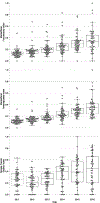Is Public Interest Associated with Real-World Management of Ankyloglossia?
- PMID: 38219744
- PMCID: PMC11507240
- DOI: 10.1002/ohn.643
Is Public Interest Associated with Real-World Management of Ankyloglossia?
Abstract
Objectives: Assess the relationship between public interest in ankyloglossia as determined by internet search volume and real-world medical claims data.
Study design: Retrospective Cohort Study.
Setting: This retrospective cohort study was conducted using claims data from the Merative™ Marketscan® Research Databases. The internet search data was collected from Google Trends.
Methods: Annual Google Trends data were compiled using search terms associated with "ankyloglossia" and "frenotomy" for the years 2011 to 2021. We obtained incidence of ankyloglossia diagnoses and frenotomy procedures in children under 12 months from Marketscan relative to all infants enrolled. We compared associations between search and incidence data among US states and over time.
Results: Google search correlated with ankyloglossia incidence (r = 0.4104, P = .0031) and with frenotomy incidence (r = 0.4062, P = .0034) per state. Ankyloglossia diagnoses increased with Google search index (coefficient = 0.336, 95% confidence interval [CI] 0.284, 0.388) and year (coefficient = 0.028, 95% CI 0.025, 0.031). Similarly, frenotomy procedures increased with Google search index (coefficient = 0.371, 95% CI 0.313, 0.429) and year (coefficient = 0.027, 95% CI 0.024, 0.030).
Conclusions: Associations between online ankyloglossia search trends and both diagnosis and treatment rates, persist across US regions and timeframes. Internet search trends are pivotal in shaping pediatric health care decisions, driving clinical consensus, and disseminating evidence-based information.
Keywords: ankyloglossia; claims database; frenotomy; google trends; tongue tie.
© 2024 American Academy of Otolaryngology–Head and Neck Surgery Foundation.
Conflict of interest statement
Figures


Similar articles
-
Ankyloglossia and Lingual Frenotomy: National Trends in Inpatient Diagnosis and Management in the United States, 1997-2012.Otolaryngol Head Neck Surg. 2017 Apr;156(4):735-740. doi: 10.1177/0194599817690135. Epub 2017 Feb 7. Otolaryngol Head Neck Surg. 2017. PMID: 28168891 Free PMC article.
-
Ankyloglossia: Update on Trends in Diagnosis and Management in the United States, 2012-2016.Otolaryngol Head Neck Surg. 2020 Nov;163(5):1029-1031. doi: 10.1177/0194599820925415. Epub 2020 May 19. Otolaryngol Head Neck Surg. 2020. PMID: 32427523
-
Trends of ankyloglossia and lingual frenotomy in hospital settings among children in Denmark.Dan Med J. 2020 May 1;67(5):A01200051. Dan Med J. 2020. PMID: 32351198
-
Major complications after tongue-tie release: A case report and systematic review.Int J Pediatr Otorhinolaryngol. 2020 Nov;138:110356. doi: 10.1016/j.ijporl.2020.110356. Epub 2020 Sep 1. Int J Pediatr Otorhinolaryngol. 2020. PMID: 32927351
-
Comparison of Frenotomy Techniques for the Treatment of Ankyloglossia in Children: A Systematic Review.Otolaryngol Head Neck Surg. 2020 Sep;163(3):428-443. doi: 10.1177/0194599820917619. Epub 2020 Jun 2. Otolaryngol Head Neck Surg. 2020. PMID: 32482127
References
-
- Messner AH, Lalakea ML. The effect of ankyloglossia on speech in children. Otolaryngol Neck Surg. 2002;127(6):539–545. - PubMed
MeSH terms
Grants and funding
LinkOut - more resources
Full Text Sources
Miscellaneous

